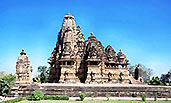|
HINDU and JAIN TEMPLES at
|

|
HINDU and JAIN TEMPLES at
|

In Khajuraho in middle India, a mere small village nowadays despite having been an ancient capital city, there still exist 25 stone temples from 85 that were constructed from the 10th to the 12 centuries, the prosperous age of the Chandella Dynasty. The superb sculptures carved on their sandstone walls are unparalleled in any other regions in those days. The statues In particular, covering almost all walls, are world famous by their sensual expression. Here, anonymous sculptors immortalized, in invigorating innocence, the instructions of the “Kama Sutra,” a classic work of theoretical literature on human sexual love in ancient India. |
|
Tribes coming from Central Asia since the 5th century amalgamated with native people in western India and formed a militaristic clan called Rajputs. They were Hinduized, purported to be the descendants of the ancient Kshatriya cast (class of kings and warriors), and established many kingdoms in western India. The Hindu and Jain temples on land of around 6 square km ( 2km from east to west and 3km from north to south) were built over 200 years from the early 10th century. Their architectural styles are wholly unified, right up to the stage of completion. It is said that there were as many as 85 temples constructed in the city during the reign of the Chandella Dynasty.
 
When the famous Arab traveller Ibn Battuta, from Tangier in Morocco, visited here in 1335, more than 100 years after the Muslim conquest of the Bundelkhand region, it is likely he looked at the still pristine temples. However, this land was later forgotten, getting buried in dense vegetation till its rediscovery in the 20th century.
The extant 25 temples are roughly divided into three groups of west, east, and south. The eastern group embraces the most numerous, all Hindu temples, the main ones of which are surrounded with a wall, arranged like a park lawn and managed by the Archaeological Survey of India.
  PLAN of Kandariya Mahadeva Temple and backside appearance The temple soaring at the farthest place in the western group is the largest, Kandariya Mahadeva Temple, the height of which attains to 31m. Its sandstone tower stretching to the sky is called ‘Shikhara.’ It is composed of as many as 84 smaller Shikharas, analogous to the whole shape, piled up one on another.
While Indian mediaeval temple architecture is divided into two styles, the northern and southern, the great temples in Khajuraho show the completed figures of the northern style.
Although most of the Hindu temples in Khajuraho belong to the sect of Vaishnavism (worshipping Vishnu), the Kandarya Mahadeva Temple is dedicated to Shiva. It can be said that this temple was likened to Mt. Kailasa, the abode of Shiva in the Himalayas.

The sculptures on the walls of the extant 25 temples in Khajuraho are the works of a group of prominent sculptors, and the best representatives of mediaeval Indian art. The statues of gods and goddesses, glamorous celestial nymphs, imaginary animals, and sensual statues of embracing couples, called ‘Mithunas,’ are the expressions of the sculptors’ boundless imagination, covering the walls throughout inside and out.
The other temples in the western group, such as the Lakshmana Temple dedicated to Shiva and the Vishvanatha Temple (1002), are also filled with numbers of sculptures on the wall and consist of high Shikhara-like roofs from the porch to the sanctuary. They show eloquently that this place was the center of the now disappeared capital. In today’s India, at least in public places, erotic things are discreetly excluded, only on religious sculptures in ancient temples are such depictions permitted, said Khushwant Singh.ples are such depictions permitted, said Khushwant Singh.

The Matangeshwara Temple in the western group, crowded by the faithful still now, enshrines a large stone Linga, symbol of Shiva, as high as 2.5m. This temple is a single hall type used before the establishment of the Khajuraho Style and its wall sculptures have been lost. The Varaha Temple in front of it enshrines a statue of Varaha (boar), an incarnation of Vishnu. The oldest in Khajuraho, the Chaunsath Yogini Temple, dedicated to the goddess Kali, was built of granite in around 900. This temple consisted of 64 small shrines encircling an extensive courtyard. Each shrine had a statue of Yogini, a female attendant of Kali, but only half of the shrines survive.

As for the eastern group, there is a Jain area, containing three temples and many small shrines. The largest is the Parshvanatha Temple dedicated to the 23rd Tirthankara (founders of Jainism) of that name. It was constructed in the middle of the 10th century, earlier than the great temples in the western group. Though the temples here do not have balconies, the sculptures on their walls are excellent; a girl is writing a letter, another is putting on clothes, or adorning herself with flowers. They are among the masterpieces of Chandella Dynasty art. However, there are almost no differences between Hinduism and Jainism in the styles of their architecture and sculpture. In daily lives, Jaina monks follow quite rigorous disciplines. They always wear masks in order not to accidentally swallow flying insects due to the doctrine of never killing any creatures.
 
The Duladeo Temple in the southern group is dedicated to Shiva, and is covered with splendid carvings. It was built in the 12th century, in the period after the high tide of Chandella architecture and was probably the last building of that dynasty. Khajurho is the sole village in India that has an airport with the name of the village. Every March the village holds a traditional dance festival, utilizing the temples as stages for the event. (In "UNESCO World Heritage" vol. 5. 1997, Kodan-sha ) |